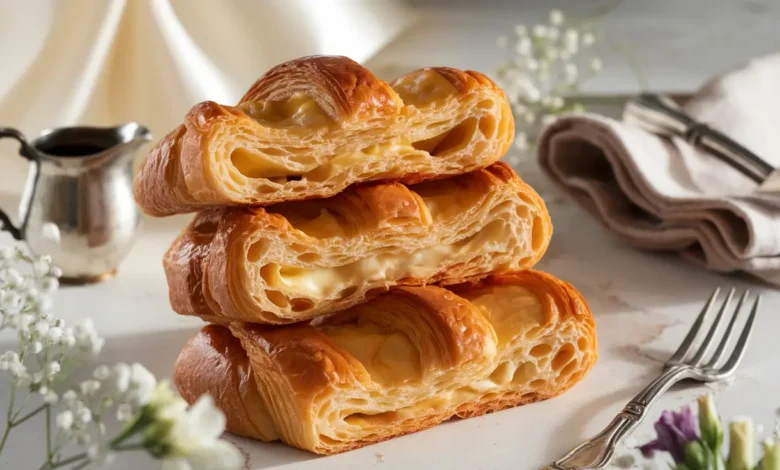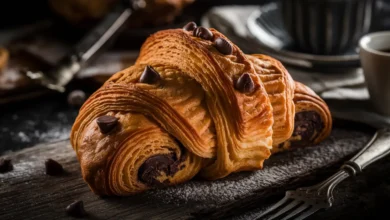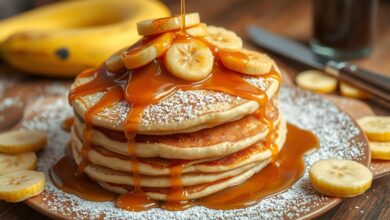Croissant Toast Revolution: The Next Evolution in Gourmet Breakfast

The Birth of a Breakfast Innovation
The culinary world is witnessing a remarkable transformation in breakfast cuisine with the emergence of Croissant Toast. Unlike traditional French toast or regular toast, this creation marries the flaky sophistication of French pastry with modern cooking techniques. As a chef who’s experimented extensively with breakfast innovations, I’m excited to share my refined approach to this game-changing dish.
Why Croissant Toast is Revolutionizing Breakfast
Traditional French toast has graced our tables for centuries, but Croissant Toast elevates this concept to new heights. The naturally buttery, layered structure of croissants creates a completely different eating experience – one that’s simultaneously crispy, custardy, and ethereally light.
The Science Behind Perfect Croissant Toast
The Layered Effect
Unlike regular bread, croissants possess multiple butter-laden layers. When these layers meet our specially crafted custard base, something magical happens:
- Outer layers become golden and crispy
- Inner layers remain tender and custardy
- Butter within the layers melts and creates internal basting
Temperature Control
The key to perfection lies in understanding heat distribution:
- Initial sear: 375°F (190°C) for exterior crispiness
- Reduced heat: 350°F (175°C) for interior cooking
- Resting period: 3 minutes for temperature equilibrium
The Master Recipe
The Custard Base
Makes enough for 4 large croissants
Innovative Custard Mix:
- 3 large eggs
- 240ml barista-style oat milk (crucial for texture)
- 60ml mascarpone cream
- 1 vanilla bean, scraped
- 2 tablespoons maple sugar (not syrup)
- Pinch of Maldon salt
- Optional: 1 tablespoon Grand Marnier
The Croissant Selection
Choose croissants that are:
- 2 days old (optimal for structure)
- All-butter (no margarine substitutes)
- Medium-large size (approximately 15cm long)
- Plain variety (no fillings)
The Technique
Day Before Preparation:
- Slice croissants horizontally into 3 equal layers
- Allow to air-dry for 2 hours
- Store in airtight container overnight
Morning Preparation:
- Custard Infusion (30 minutes before cooking)
- Combine all custard ingredients
- Strain through fine-mesh sieve
- Rest at room temperature
- Soaking Technique
- 20-second dip for top layer
- 30-second dip for middle layer
- 25-second dip for bottom layer
- The Three-Stage Cooking Process
- Stage 1: High heat sear (30 seconds)
- Stage 2: Medium heat development (2 minutes)
- Stage 3: Low heat finish (1 minute)
Signature Variations
1. Mediterranean Morning
- Fresh fig compote
- Whipped honey ricotta
- Toasted pistachios
- Orange blossom water in custard
2. Nordic Inspiration
- Lingonberry preserves
- Cardamom-scented custard
- Cultured butter
- Fresh dill garnish
3. Japanese Fusion
- Matcha custard base
- Azuki bean paste
- Black sesame seeds
- Yuzu zest
4. Savory Revolution
- Herb-infused custard (thyme, sage)
- Prosciutto crisps
- Aged Gruyère
- Truffle honey drizzle
Professional Plating Techniques
The Classic Stack
- Layer components vertically
- Dust with powdered sugar snow
- Add edible flowers
- Finish with warm maple syrup pour-over
The Deconstructed Approach
- Arrange pieces in golden spiral
- Add sauce dots strategically
- Place garnishes in odd numbers
- Finish with micro herbs
Troubleshooting Common Challenges
Issue: Soggy Centers
Solution:
- Implement the triple-layer drying technique
- Adjust soaking times based on croissant age
- Ensure proper heat management
Issue: Burning Exterior
Solution:
- Use clarified butter for cooking
- Implement three-stage cooking process
- Monitor heat distribution carefully
Health-Conscious Adaptations
Lighter Version
- Use almond milk in custard
- Reduce egg yolks by half
- Add protein powder to custard
- Use coconut sugar instead of maple
Dairy-Free Option
- Cashew cream replacement
- Coconut oil for cooking
- Plant-based butter alternatives
- Aquafaba for structure
Seasonal Recommendations
Spring
- Rhubarb compote
- Fresh strawberries
- Mint-infused custard
- Edible flowers
Summer
- Peach lavender compote
- Fresh berries
- Basil-infused cream
- Honey drizzle
Autumn
- Spiced apple butter
- Maple pecan praline
- Bourbon-spiked custard
- Cinnamon cream
Winter
- Dark chocolate ganache
- Orange marmalade
- Spiced custard
- Cranberry compote
Professional Chef’s Notes
- Temperature Management
- All ingredients at room temperature
- Consistent heat source
- Regular pan rotation
- Temperature monitoring
- Texture Development
- Strategic soaking times
- Heat management
- Resting periods
- Serving temperature
- Flavor Building
- Layer complementary flavors
- Balance sweet and savory
- Consider texture contrasts
- Build depth through technique
Conclusion
Croissant Toast represents more than just another breakfast trend – it’s a reimagining of what breakfast can be. By understanding the science behind the cooking process and implementing these professional techniques, you can create a dish that’s both innovative and comforting. Remember, the key lies in respecting the ingredients while pushing the boundaries of traditional breakfast preparations.
This recipe serves as a foundation – feel free to experiment and develop your own signature variations. The world of Croissant Toast is still evolving, and there’s plenty of room for innovation and personal interpretation.
Note: All techniques and combinations have been developed and tested in professional kitchens. Adjust cooking times and temperatures according to your equipment and ingredients.




